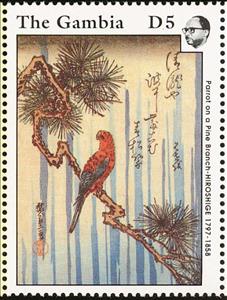Stamp: Parrot on a Pine Branch (Gambia 1989)
Parrot on a Pine Branch (Gambia 1989)
07 July (Gambia ) within release Japanese Paintings goes into circulation Stamp Parrot on a Pine Branch face value 5 Gambian dalasi
| Stamp Parrot on a Pine Branch in catalogues | |
|---|---|
| Stamp Number: | Sn:GM 866 |
Stamp is square format.
By HiroshigeAlso in the issue Japanese Paintings:
- Stamp - Mandarin Ducks in a Stream face value 10;
- Stamp - Bullfinch and Cherry face value 12;
- Souvenir Sheet - Tit and Peony face value 15;
- Souvenir Sheet - Peony and Butterfly face value 15;
- Stamp - Sparrow and Bamboo face value 50;
- Stamp - Peonies and a Canary face value 75;
- Stamp - Crane and Marsh Grasses face value 1;
- Stamp - Crossbill and Thistle face value 1.25;
- Stamp - Cuckoo and Azalea face value 2;
- Stamp - Parrot on a Pine Branch face value 5;
- Stamp - Peony and Butterfly face value 15;
- Stamp - Tit and Peony face value 15;
Stamp Parrot on a Pine Branch it reflects the thematic directions:
Birds (Aves), a subgroup of Reptiles, are the last living examples of Dinosaurs. They are a group of endothermic vertebrates, characterised by feathers, toothless beaked jaws, the laying of hard-shelled eggs, a high metabolic rate, a four-chambered heart, and a strong yet lightweight skeleton. Birds live worldwide and range in size from the 5 cm (2 in) bee hummingbird to the 2.75 m (9 ft) ostrich. They rank as the class of tetrapods with the most living species, at approximately ten thousand, with more than half of these being passerines, sometimes known as perching birds. Birds are the closest living relatives of crocodilians.
Painting is the practice of applying paint, pigment, color or other medium to a solid surface (support base). The medium is commonly applied to the base with a brush, but other implements, such as knives, sponges, and airbrushes, can be used. Painting is a mode of creative expression, and the forms are numerous. Drawing, gesture (as in gestural painting), composition, narration (as in narrative art), or abstraction (as in abstract art), among other aesthetic modes, may serve to manifest the expressive and conceptual intention of the practitioner. Paintings can be naturalistic and representational (as in a still life or landscape painting), photographic, abstract, narrative, symbolistic (as in Symbolist art), emotive (as in Expressionism), or political in nature (as in Artivism). A portion of the history of painting in both Eastern and Western art is dominated by spiritual motifs and ideas. Examples of this kind of painting range from artwork depicting mythological figures on pottery, to Biblical scenes rendered on the interior walls and ceiling of the Sistine Chapel, to scenes from the life of Buddha or other images of Eastern religious origin. In art, the term painting describes both the act and the result of the action. The support for paintings includes such surfaces as walls, paper, canvas, wood, glass, lacquer, clay, leaf, copper and concrete, and the painting may incorporate multiple other materials including sand, clay, paper, plaster, gold leaf, as well as objects. The term painting is also used outside of art as a common trade among craftsmen and builders.
Parrots (Psittaciformes), also known as psittacines (/ˈsɪtəsaɪnz/), are birds with a strong curved beak, upright stance, and clawed feet. They are classified in four families that contain roughly 410 species in 101 genera, found mostly in tropical and subtropical regions. The four families are the Psittaculidae (Old World parrots), Psittacidae (African and New World parrots), Cacatuoidea (cockatoos), and Strigopidae (New Zealand parrots). One-third of all parrot species are threatened by extinction, with a higher aggregate extinction risk (IUCN Red List Index) than any other comparable bird group Parrots have a generally pantropical distribution with several species inhabiting temperate regions as well. The greatest diversity of parrots is in South America and Australasia



